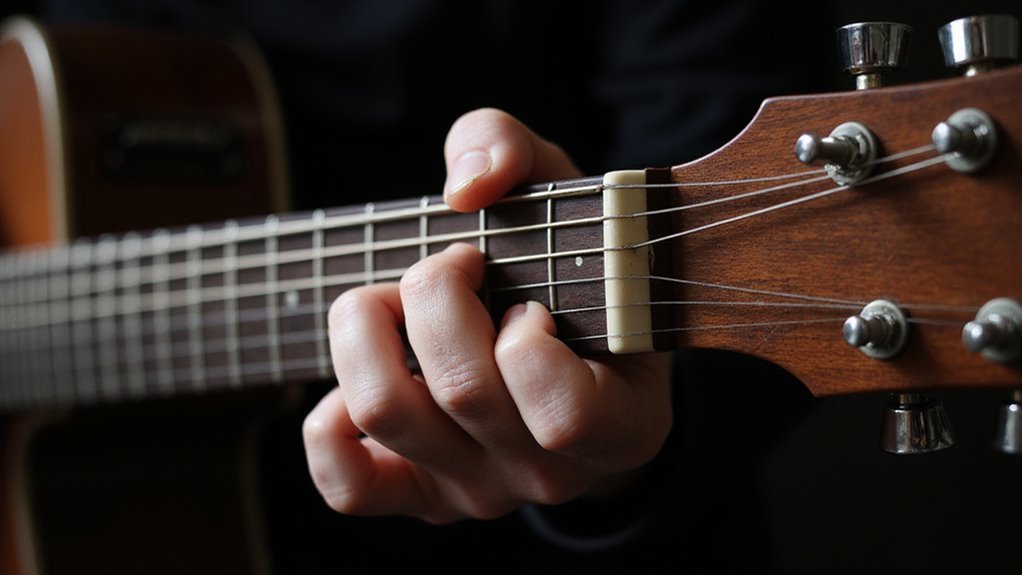Your hands work together yet apart, each mastering different skills on the guitar, and your left hand deserves special attention. I’ve noticed many beginners struggle with proper thumb positioning and finger independence, often creating unnecessary tension. You’re probably familiar with that hand cramping after practicing barre chords for too long—I certainly am! Perhaps the most significant breakthrough in your playing will come not from learning new songs, but from revisiting how your left hand approaches the fretboard.
Understanding Left Hand Anatomy and Optimal Positioning

The human hand is an incredible instrument in itself, one you’ll need to thoroughly understand if you want to master the guitar. Your left hand (assuming you’re right-handed) contains 27 bones, with three joints in each finger that must work independently to create beautiful music.
Proper positioning is everything. Your thumb should rest behind the neck, creating a “C” shape with your hand. This might feel awkward at first, but I promise it prevents fatigue and gives you better reach across the fretboard.
Essential Exercises for Developing Finger Independence

While mastering the guitar requires numerous skills, developing finger independence stands as perhaps the most essential foundation for your technical growth. Your fingers naturally want to move together, but on guitar, they need to operate independently – a challenge many players struggle with.
| Exercise | Benefit | Practice Time |
|---|---|---|
| Spider Walks | Coordination | 5-10 minutes |
| Static Finger Stretch | Flexibility | 3-5 minutes |
| One-Finger-Per-Fret | Strength | 5-7 minutes |
| String Skipping | Accuracy | 5 minutes |
| Finger Lifts | Control | 3 minutes |
Start slowly with these exercises – speed isn’t your initial goal. Feel the individual movement of each finger and you’ll notice improvement within weeks.
Building Strength and Endurance Without Strain

Now that you’ve mastered the fundamental exercises for finger independence, let’s focus on developing something equally important – strength and endurance in your left hand without causing injury.
This is perhaps the trickiest balance to strike, as many guitarists push too hard too quickly. Your left hand needs both power and stamina, but building these shouldn’t hurt. I think a gradual approach works best for most players:
- Start with 10-15 minute sessions of barre chord practice daily
- Incorporate finger stretches before and after playing
- Use a hand exerciser (like a stress ball) on your off-days
Mastering Advanced Techniques: Barre Chords and Beyond
Ever wondered why some advanced techniques seem impossible at first? It’s because they demand that perfect coordination we’ve been building.
Barre chords, perhaps the most intimidating hurdle, require your index finger to become a movable “nut” across multiple strings.
Don’t get discouraged if your first attempts sound buzzy. I think everyone struggles here. Try applying pressure from your arm rather than squeezing with your hand – this prevents fatigue.
Beyond barres, explore techniques like hammer-ons, pull-offs, and slides. These add expression to your playing and, honestly, they’re what make guitar feel magical once mastered.
Preventing Fatigue and Injury Through Proper Practice
Learning advanced techniques is just half the battle – protecting your hands for the long haul matters just as much.
Technique without sustainability is futile – your musical longevity depends on how well you care for your hands.
I think many guitarists overlook this vital aspect until they experience that first painful cramp or persistent wrist ache. Proper practice habits create sustainability in your playing journey.
Here are three essential practices to prevent fatigue and injury:
- Take frequent 30-second breaks every 15-20 minutes of practice
- Perform gentle hand stretches before and after playing
- Maintain relaxed positioning – your thumb shouldn’t be gripping too tightly
Frequently Asked Questions
How Long Until I See Improvement in My Left Hand Technique?
You’ll see results in 2-4 weeks with daily practice, but don’t get discouraged. Consistency matters more than duration. Track your progress with recordings to notice subtle improvements.
Can Playing Other Instruments Improve My Guitar Left Hand Skills?
You’re barking up the right tree! Piano builds finger independence, violin develops precision, and percussion enhances rhythm. These skills transfer beautifully to your guitar playing, accelerating your left hand development.
Should I Practice Left Hand Techniques Differently for Electric vs. Acoustic?
Yes, you’ll need to adapt your technique. On electric, use lighter pressure and focus on speed, while acoustic requires more strength and precise finger placement for clean notes.
How Do Age-Related Hand Issues Affect Left Hand Technique Development?
Age can reduce flexibility and strength in your hands. You’ll need to focus more on warm-ups, gentler stretching exercises, and possibly adjust your technique to accommodate joint stiffness or arthritis.
Can Nutrition or Supplements Improve Left Hand Playing Strength and Recovery?
70% of guitarists see improved recovery with proper hydration. You’ll benefit from omega-3s for inflammation, magnesium for muscle function, and vitamin D for strength. Don’t forget collagen supplements can aid tendon repair.
Conclusion
Your fingers will dance across the fretboard like nimble acrobats as you master these left-hand techniques. Remember, it’s not just about practice—it’s about smart practice. Give your hand the occasional rest, shake out the tension, and visualize success before you play. With patience and these targeted exercises, you’ll transform from fumbling to fluid, creating music that flows as naturally as breathing.